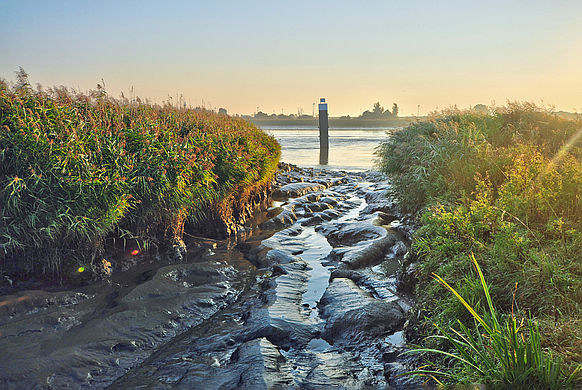The Ems is in poor ecological condition. The water contains little oxygen, a lot of suspended matter, and too much salt. This state is a consequence of, among other things, the increasing deepening of the river since the '80s that has disorganised the tidal balance so much that the Ems can no longer independently carry out with the ebb all of the silt that washes in with the flow. Typical riverbank habitats like riparian forests, reeds, and tidelands with tidal creeks have vanished in many areas, and elsewhere they are in danger of vanishing as the Ems was straightened and fortified, thereby destroying nearly natural riverbank zones.
It is thus necessary to act, especially as the European Commission has made it clear with a so-called "pilot procedure" that it will not continue to tolerate violations of numerous European environmental standards in the long term, thereby obligating the state of Lower Saxony to improve the situation.
The contract partners have thus defined concrete measures that aim to improve water quality and habitats in the Master Plan Ems 2050. As a result, the European Commission has initially suspended the pilot procedure, but would like to be informed semiannually of progress in the Ems. The threatened contract violation proceedings before the European Court of Justice, with potentially high penalties, is thus not completely off the table.
The quality of the water is most troubling. A cloud of loose silt washes to and fro with every flow into the river, and when combined with the lack of oxygen and rising salt levels this makes life difficult or impossible for a lot of aquatic wildlife and plants, especially in the summer. Microscopic creatures that primarily consume the organic components of the silt need the oxygen released into the water to do so.
A number of solutions to this problem are considered in the assessment. A tidal control system is to be installed in the Ems barrage that would use a bearing threshold or technical regulation of flow conditions to halt the incoming silt. So-called tidal polders – newly dredged basins along the edge of the river – will gather water and silt. The outflow from the polders should strengthen the ebb current over time, thereby helping to wash out the silt.
But that is not the only solution. The objective "Giving the River More Room" foresees the formation of "typical estuary habitats" like tidal riparian forests, reeds, and tidelands with tidal creeks along the banks of the Ems through the targeted acquisition of space and the installation of polders. The new system of such tide-dependent areas along the river should compensate for the loss of such habitats, giving flora and fauna the chance to recover or resettle. The Master Plan Ems foresees the acquisition of 500 hectares by the year 2050. An additional 200 hectares of meadow bird habitat will be created inland by 2050 to replace the grassland areas claimed in the foreland.
Structures that currently prevent fish and other animals from straying into bodies of water adjacent to the Ems shall be made more traversable throughout the duration of the Master Plan Ems 2050.






